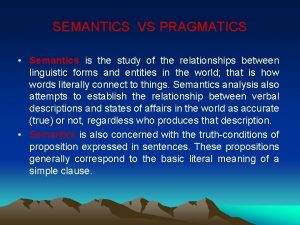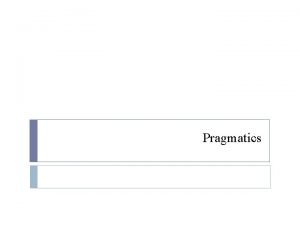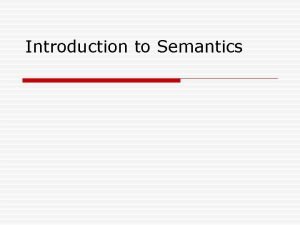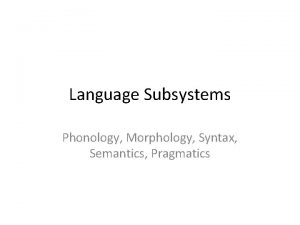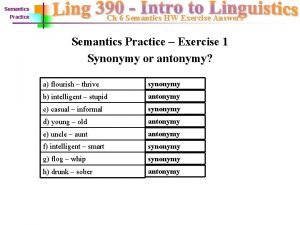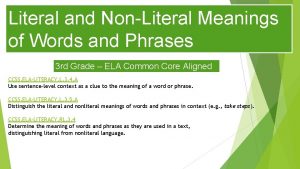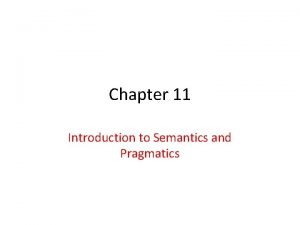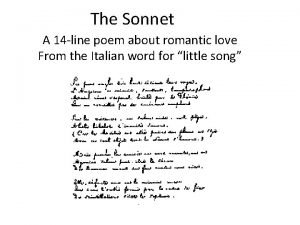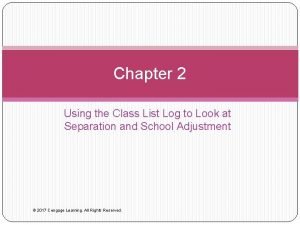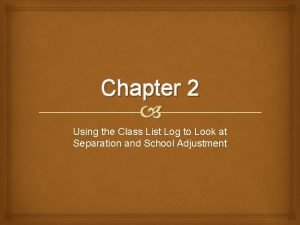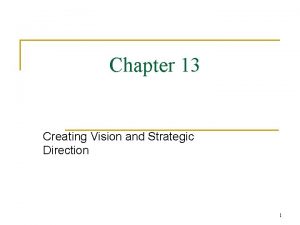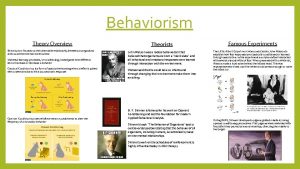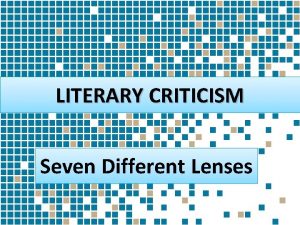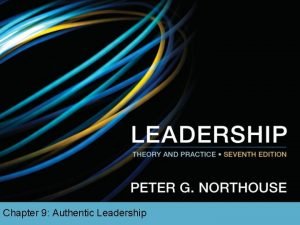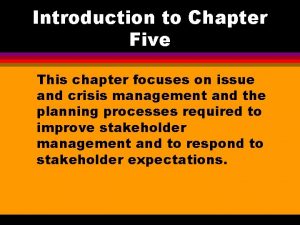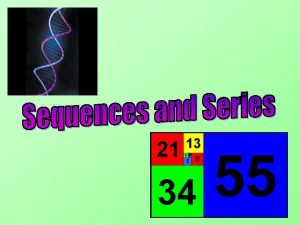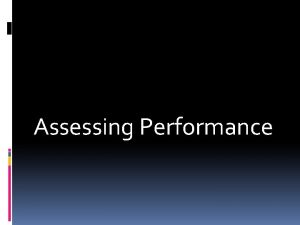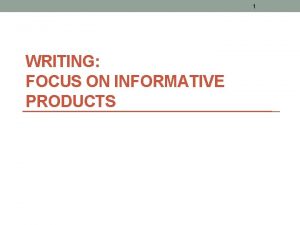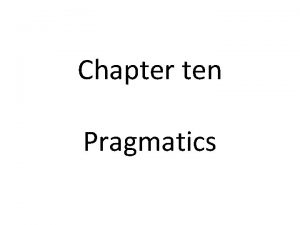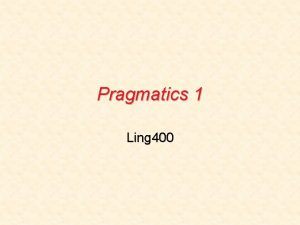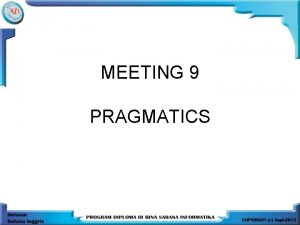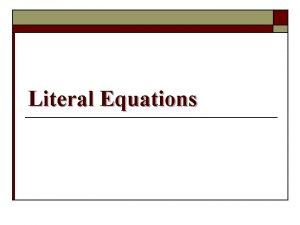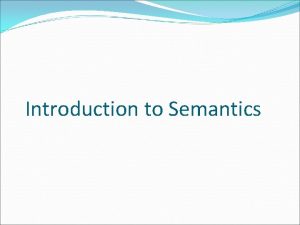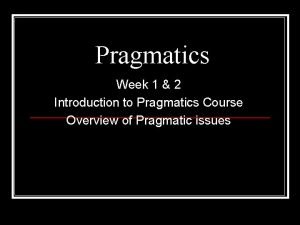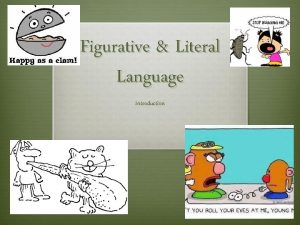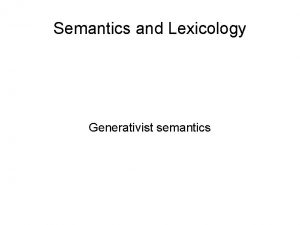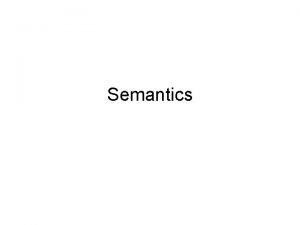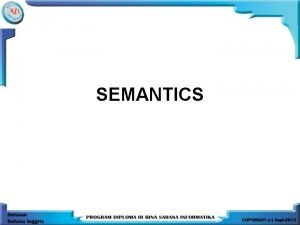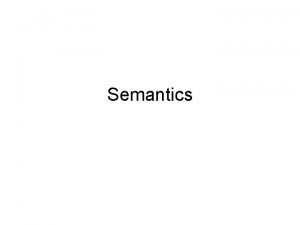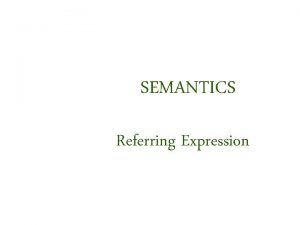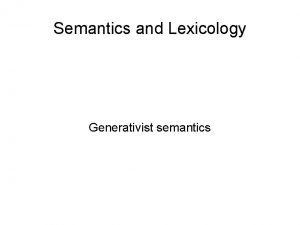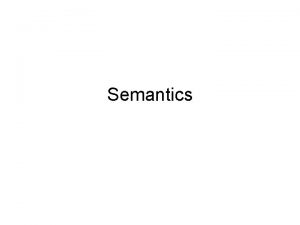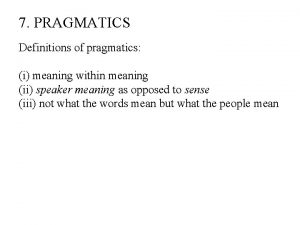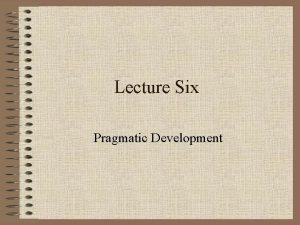Introduction to Pragmatics Semantics Focuses on the literal






































































- Slides: 70

Introduction to Pragmatics

Semantics � Focuses on the literal meanings of words, phrases and sentences; � concerned with how grammatical processes build complex meanings out of simpler ones

Semiotic triangle

Pragmatics � Focuses on the use of language in particular situations; � aims to explain how factors outside of language contribute to both literal meaning and nonliteral meanings which speakers communicate using language

Pragmatics vs. semantics � The study of meaning in use � Provides tools to help us understand the meaning in a given social context, including the effect that language has on those involved in the speech situation � Semantics – the study of meaning outside of its contextualized use with a focus on the literal meaning of words and phrases

Pragmatics v. semantics � Semantics – concerned with what language says � Pragmatics – concerned with what language can do � Semantics – sense � Pragmatics – force � Semantics: words or lexemes are central to the study � Pragmatics: events or potential events are of main interest

Pragmatics � Speech act theory � Conversational implicature � Deixis � Presupposition

Speech act theory � We often think that the role of language is to explain, inform, describe, and say sth about the world � Language – also used to do things, such as promise, bet, request, threaten, warn, apologize, swear (in court), etc.

Speech act theory Austin, How to do Things with Words (1955) � "It was for too long the assumption of philosophers that the business of a 'statement' can only be to 'describe' some state of affairs, or to 'state some fact', which it must do either truly or falsely. „ � Wittgenstein: „Don't ask for the meaning, ask for the use. " - language as a vehicle for social activity � J. L.

Speech Act Theory � Austin suggested that most utterances are created not to ‘describe’, but to perform action � His approach was not of „What do sentences mean? ” but „What kind of act do we perform when we utter a sentence? ”

Speech Act Theory � Austin emphasized the contexts in which utterances take place and suggested that they should be defined as felicitous or not, rather than false or true � Felicity conditions: describe all the circumstantial properties of an utterance which are relevant to its successful accomplishment

Speech act theory � Austin questioned the truth value of statements, a view which centered on the conditions of an utterance that can be declared true or false � Austin examined performatives: sentences that are used to do things, rather than declare or state sth

Speech acts � Performatives: „I now pronounce you husband wife” � Only certain people in certain conditions can do this kind of pronouncing; if the conditions are right, then a change has taken place through the uttering the words

Exercise � Make a list of performative utterances. � What new state of affairs do the utterances create? � What conditions must be present for the new state of affairs to come about?

Speech acts I promise to visit tomorrow � B) She promised to visit tomorrow � A) � Sentences which perform actions – performatives (A); other sentences (B) – constatives � A good test of whether a sentence is a performative is whether you can insert the word hereby before the verb (I hereby promise; *I hereby walk)

Speech Act Theory � Syntactic � 1) � 2) � 3) � 4) � 5) markers of a performative utterance: the subject is in the 1 st person the verb is in the simple present tense the indirect object is ‘you’ it is possible to insert the adverb ‘hereby’ the sentence is not negative

Performatives � Speech acts which in themselves constitute an action � This aspect of language – illocutionary force � The illocutionary force of an utterance is its ability to carry out an act

Speech acts � Locutionary act: the act of saying sth � Illocutionary act: the act of doing sth by saying sth � Perlocutionary act: the act of achieving sth by saying sth

Speech acts � John Searle took work on speech acts further by introducing direct ad indirect speech acts � "In indirect speech acts the speaker communicates to the hearer more than he actually says by way of relying on their mutually shared background information, both linguistic and nonlinguistic, together with the general powers of rationality and inference on the part of the hearer”

Speech acts � There are speech acts which are so fundamental to communication that they are captured through the mood of our utterance: � Indicative mood: giving information � Interrogative mood: request for information � Imperative mood: command to do sth

Speech acts � The mood of each utterance signals its illocutionary force � Context – key in explaining what people are trying to do with the language they use

Exercise: write the common locutionary act of the underlined words, illocutionary act and the perlocutionary act � Scenario 1: (in an elevator, 3 people, A and B know each other, C is smoking: � A (to B): Ahem, did I ever tell you that I am allergic to cigarette smoke? � Scenario 2: (A is filling in a form for a dating service): A (writing on form): I am allergic to cigarette smoke.

Exercise: for each utterance, state the mood. Then state the direct speech act which it could represent, and the indirect speech act which it more likely represents � 1. Would you mind handing me the salt? � 2. Go ahead, try it. See where that’ll get you! � 3. Honey, the phone’s ringing! � 4. I have always wanted to have a pair of earrings just like those. � 5. I’m sure I must look awful.

Key � 1. DSA = requesting information ISA = commanding or requesting service � 2. DSA = commanding ISA = warning � 3. DSA = informing ISA = requesting a service � 4. DSA = informing ISA requesting (a gift? ) � 5. DSA = informing ISA fishing for complement/apologizing for state

Linguistics and the law � The function of the legal language – usually seen as directive: used to impose obligations or to confer rights, to command or empower: mandatory and discretionary law � Law uses language as a tool, an instrument for achieving things in the world; linguistics – language as an object of study

Speech act theory and the law � In the communication process, whenever acts become formalised, they involve rules and conventions, or ‘shared group commitments’, which seem to correspond to J. Austin’s felicity conditions and allow to recognise whether the act is valid or not

Speech act theory and the law � H. L. A. Hart commented on linguistic speech acts and pointed to their correspondence with formal legal acts such as the transfer of property or making of a will � Suggested that performative utterances should be called operative utterances, evoking the analogy with what lawyers called ‘operative words’ in legal language

Speech act theory and the law � Acts in law presuppose that the performer, in order to perform the act, needs to be able to exercise their legal power � These powers, e. g. to enter a contract, to make a will, or even to enact a law, presuppose ‘power conferring rules’ which stipulate which persons and under which conditions can perform the act

Intention in legal documents � The interpretation of any legal document requires analysis of a relevant intention which has been incorporated into the text � The notion of intentionality relates to the problem of implicitness and explicitness in language � Grice’s conversational implicatures (1975)

Grice’s conversational maxims � Imagine you overhear the following conversation: � A: Are John and Mary back together again? � B: I saw a red Porche parked outside 1128 Green Street last night…and it was still there this morning!

Grice’s conversational maximes � In the exchange above, we might assume that B’s response is providing A with the information requested. � We can make the connection between the question and the answer by relying on presupposition: B presupposes that A also knows the following: � John has a red Porche � Mary lives at 1128 Green Street

Grice’s Cooperative Principle � In order to help us understand how context works in deciphering meaning in a given situation, we can look to Grice’s Cooperative Principle, which explains how people act in conversation: ‘Make your conversational contribution such as is required, at the stage at which it occurs, by the accepted purpose or direction of the talk exchange in which you are engaged’

Grice’s conversational maximes � Grice is not telling us what to do, but rather providing an explanation for how we behave in communicative situations ad how we assume other people behave

Grice’s conversational maximes � Grice further divided his Cooperative Principle into sub-principles of: � Quantity � Relevance � Quality � Manner

Grice’s conversational maximes � Quantity: � Maxim 1. Make your contribution as informative as is required � Maxim 2. Do not make your contribution more informative than is required.

Grice’s conversational maximes � Relevance: � Maxim 1. Be relevant.

Grice’s conversational maximes � Quality: � Maxim 1: Do not say what you believe to be false. � Maxim 2. Do not say that for which you lack adequate evidence.

Grice’s conversational maximes � Manner: � Maxim 1: � Maxim 2. � Maxim 3. � Maxim 4. Avoid obscurity of expression. Avoid ambiguity. Be brief. Be orderly.

Grice’s conversational maximes � When we break any of the sub-principles, we create an instance of conversational implicature: � A: I heard you did well on the exam � B: Yes, and pigs fly. � Flouting the maxim of quality, as I am telling an obvious untruth

Grice’s conversational maximes: options � Observing the maxims � Violating one or more maxims (e. g. lying) � Opting out (e. g. refusing to answer a direct question) � Not fulfilling one maxim because of a clash with another � Flouting a maxim in order to make a conversational implicature

Conversational implicature � 1. The speaker deliberately flouts a conversational maxim to convey additional meaning not expressed literally, e. g. a speaker responds to the question: „How did you like the guest speaker? ” with the following utterance: „Well, I’m sure he was speaking English”. � If the speaker is assumed to be following the cooperative principle in spite of flouting the Maxim of Quantity, the utterance must have an additional nonliteral meaning, such as: „The content of the speech was confusing. ”

Conversational implicature � 2. The speaker’s desire to fulfil two conflicting maxims results in his flouting one maxim to invoke the other, e. g. when he responds to the question „Where is John? ” by saying: He’s either in the cafeteria or in his office � The Maxim of Quantity and the Maxim of Quality are in conflict: a cooperative speaker doesn’t want to be ambiguous but also doesn’t want to give false information by giving a specific answer in spite of his uncertaity. By flouting the Maxim of Quantity, he invokes the Maxim of Quality

Exercise: suggest which maxim is being flouted (Quality, Quantity, Relevance, Manner) and what is being communicated through that flouting � A. How’s your work coming along? � B. It sure is sunny outside.

Key �B is flouting the maxim of relevance. Given that B responds with an utterance which is clearly irrelevant, A can assume that work is NOT coming along

Which maxim is flouted? (Quality, Quantity, Relavance, Manner) � 1. In a recommendation letter for a sales job: � Dear Sir, I have been asked to write a few lines in suport for Jon Smith’s application for work in sales within your company. What perhaps is most ipressive about John is that his appearance is impeccable, and his class attendance has been faultless. Sincerely, A.

Key � The maxim of quantity, the letter is not very informative. This seems t ocommunicate that A does not have very much to say that is positive about John, and to avoid violatind the maxim of Quality and lying, and to avoid attacking John, A is not as informative as the situation requires

Exercise: Quantity, Quality, Relevance, Manner � 2. A. Do you like Anne’s new shoes? B: I can’t imagine where she’s got them from. � B flouts the Maxime of Relevance, as the utterance does not answer A’s question, perhaps to avoid either disagreeing with A or violating the Maxim of Quality and lying about liking the shoes

Exercise: Quantity, Quality, Relevance, Manner � Do you think the kids would like some of that freezing cold creamy concoction that could be served in an edible dylinder-like container? � A flouts the Maxim of Manner, as it would be much clearer and briefer to say ‘ice-cream’. The hearer can thus understand that A does not want the kids to know about the possibility

Exercise: Quantity, Quality, Relevance, Manner � A: How did Mary and John do on their exam? B: Mary did fine. � B flouts the Maxim of Quantity, as no information is provided about John. Thus A will assume that John did not do well, and that B does not want to provide displeasing information.

Exercise: Quantity, Quality, Relevance, Manner � A. Were you invited to John’s party? B: Were you? � B flouts the Maxim of Relevance in not providing an answer to A’s question. A might thus understand that B does not want to hurt his/her feelings

Exercise: Quantity, Quality, Relevance, Manner � A. Are you free this evening? B: I have had so much work lately! I had to finish a 20 -pages paper, my dog has been sick and I had to take him to the vet, and now my mother says she’s coming to visit this weekend! � B flouts the Maxim of Quantity/Manner – the answer is more informative than required, and it is not brief. A will probably get the picture that B is not free that evening, and will probably not follow through with a suggestion or invitation

Deixis � words and phrases that cannot be fully understood without additional contextual information � Words are deictic if their semantic meaning is fixed but their denotational meaning varies depending on time and/or place. � Words or phrases that require contextual information to convey any meaning – e. g. , English pronouns – deictic

Deixis

Deixis: traditional categories � Person � Place � Time

Person � The center of the deictic system

Place � The most salient English examples are the adverbs“here” and “there” and the demonstratives “this” and “that”, e. g. : �I enjoy living in this city � Here is where we will place the statue � She was sitting over there

Time � Time, or temporal, deixis concerns itself with the various times involved in and referred to in an utterance. � This includes time adverbs, e. g. "now", "then", "soon", etc. and also different tenses � Example: tomorrow denotes the consecutive next day after every day. The "tomorrow" of a day last year was a different day from the "tomorrow" of a day next week.

Deixis: other categories � Discourse � Social

Social deixis � concerns the social information that is encoded within various expressions, such as relative social status and familiarity. � Two major forms of it are the so-called T–V distinctions and honorifics. � T–V distinctions, named for the Latin “tu” and “vos” the name given to the phenomenon when a language has two different second-person pronouns. � The varying usage of these pronouns indicates something about formality, familiarity, and/or solidarity between the interactants, e. g. the T form might be used when speaking to a friend or social equal, whereas the V form would be used speaking to a stranger or social superior - common in European languages

Discourse � Discourse deixis, also referred to as text deixis, refers to the use of expressions within an utterance to refer to parts of the discourse that contains the utterance — including the utterance itself: e. g. This is a great story

Anaphora �. � An anaphoric reference refers to something within a text that has been previously identified, e. g. "Susan dropped the plate. It shattered loudly" the word "it" refers to the phrase "the plate". � A cataphoric reference refers to something within a text that has not yet been identified, e. g. in "He was very cold. David promptly put on his coat" the identity of the "he" is unknown until the individual is also referred to as "David".

Anaphora Do you see that baby girl over there? She is cute. � A. � When a word or phrase picks up its meaning from some other piece of language nearby, the relationship between the two – anaphora � A word which gets its meaning in this way – an anaphor, and the piece of language which gives the anaphor its meaning – its antecedent

Presupposition � Presupposition - when a speaker’s choice of words shows that he is taking sth for granted � E. g. : John stopped crying at noon – makes sense if it is assumed that John was crying just before noon.

Presupposition � an implicit assumption about the world or background belief relating to an utterance whose truth is taken for granted, e. g. : � Jane no longer writes fiction. ◦ Presupposition: Jane once wrote fiction. � Have you stopped eating meat? � Have you talked to Hans? ◦ Presupposition: you had once eaten meat. ◦ Presupposition: Hans exists.

Presupposition �A presupposition must be mutually known or assumed by the speaker and addressee for the utterance to be considered appropriate in context.

Presupposition � Presuppositions – often understood in terms of the notion of common ground � The common ground – a set of propositions which the participants in a conversation mutually assume � The common ground - a major part of the context of use, and helps us make explicit the role of presupposition

Meaning and the intention to communicate � Indexicality and presupposition – aspects of pragmatics which have to do with the relationship between context of use and semantic meaning

Culture-specific implicature � Cultural assumptions can be crucial in determining speaker’s meaning � Example: if two Chinese people are looking at the dessert display in a French restaurant, and one says to the other, “That tart is not too sweet”, she intends this comment as praise of the tart. She might intend to implicate that her dinner partner should order the tart. This meaning arises, in part, from the fact that it is common knowledge among Chinese people that most of them find western desserts too sweet. Among some other groups, the same comment could be interpreted as a criticism, rather than a compliment

Culture-specific implicature � The cultural specificity of the speaker’s meaning is not a fact about the Chinese language � The implicature could arise regardless of the language they are speaking

Pragmatics summary � Pragmatics – about how the context of use contributes to meaning � Core topics: indexicality, presupposition, implicature, speech acts
 Pragmatics example
Pragmatics example Difference between semantics and pragmatics
Difference between semantics and pragmatics Componential analysis
Componential analysis Semantic triangle example
Semantic triangle example Pragmatic definition in linguistics
Pragmatic definition in linguistics Linguistic subsystems
Linguistic subsystems Semantic exercise meaning
Semantic exercise meaning Compare procedural semantics and declarative semantics.
Compare procedural semantics and declarative semantics. Non literal examples
Non literal examples Introduction to semantics
Introduction to semantics 14 line love poem
14 line love poem Psychoanalytical criticism
Psychoanalytical criticism Developing competitive advantage and strategic focus
Developing competitive advantage and strategic focus What is a class list log
What is a class list log Effective software project management
Effective software project management Human condition magritte
Human condition magritte Sociology of physical activity focuses on
Sociology of physical activity focuses on Class list log observation example
Class list log observation example Creating vision and strategic direction
Creating vision and strategic direction Behaviorism focuses on
Behaviorism focuses on A coaching relationship focuses on providing marines
A coaching relationship focuses on providing marines Literature lenses
Literature lenses Diverse information sharing through universal web access
Diverse information sharing through universal web access Authentic leadership focuses on
Authentic leadership focuses on Developing a firms strategy canvas focuses on
Developing a firms strategy canvas focuses on This chapter focuses on
This chapter focuses on Sequences and series
Sequences and series Actually synoynm
Actually synoynm Management focuses on
Management focuses on Example of summary of story
Example of summary of story Sabar nurohman
Sabar nurohman Romanticism focuses on
Romanticism focuses on Organizational restructuring
Organizational restructuring Gsm protocol
Gsm protocol Scheduling time-constrained projects focuses on resource
Scheduling time-constrained projects focuses on resource Hình ảnh bộ gõ cơ thể búng tay
Hình ảnh bộ gõ cơ thể búng tay Bổ thể
Bổ thể Tỉ lệ cơ thể trẻ em
Tỉ lệ cơ thể trẻ em Gấu đi như thế nào
Gấu đi như thế nào Chụp tư thế worms-breton
Chụp tư thế worms-breton Hát lên người ơi
Hát lên người ơi Các môn thể thao bắt đầu bằng tiếng chạy
Các môn thể thao bắt đầu bằng tiếng chạy Thế nào là hệ số cao nhất
Thế nào là hệ số cao nhất Các châu lục và đại dương trên thế giới
Các châu lục và đại dương trên thế giới Công thức tính độ biến thiên đông lượng
Công thức tính độ biến thiên đông lượng Trời xanh đây là của chúng ta thể thơ
Trời xanh đây là của chúng ta thể thơ Mật thư tọa độ 5x5
Mật thư tọa độ 5x5 101012 bằng
101012 bằng độ dài liên kết
độ dài liên kết Các châu lục và đại dương trên thế giới
Các châu lục và đại dương trên thế giới Thơ thất ngôn tứ tuyệt đường luật
Thơ thất ngôn tứ tuyệt đường luật Quá trình desamine hóa có thể tạo ra
Quá trình desamine hóa có thể tạo ra Một số thể thơ truyền thống
Một số thể thơ truyền thống Cái miệng xinh xinh thế chỉ nói điều hay thôi
Cái miệng xinh xinh thế chỉ nói điều hay thôi Vẽ hình chiếu vuông góc của vật thể sau
Vẽ hình chiếu vuông góc của vật thể sau Thế nào là sự mỏi cơ
Thế nào là sự mỏi cơ đặc điểm cơ thể của người tối cổ
đặc điểm cơ thể của người tối cổ Thế nào là giọng cùng tên
Thế nào là giọng cùng tên Vẽ hình chiếu đứng bằng cạnh của vật thể
Vẽ hình chiếu đứng bằng cạnh của vật thể Phối cảnh
Phối cảnh Thẻ vin
Thẻ vin đại từ thay thế
đại từ thay thế điện thế nghỉ
điện thế nghỉ Tư thế ngồi viết
Tư thế ngồi viết Diễn thế sinh thái là
Diễn thế sinh thái là Các loại đột biến cấu trúc nhiễm sắc thể
Các loại đột biến cấu trúc nhiễm sắc thể Số.nguyên tố
Số.nguyên tố Tư thế ngồi viết
Tư thế ngồi viết Lời thề hippocrates
Lời thề hippocrates Thiếu nhi thế giới liên hoan
Thiếu nhi thế giới liên hoan
